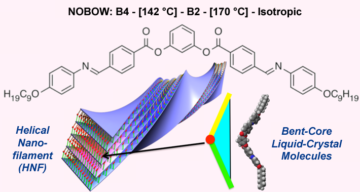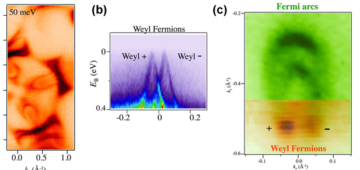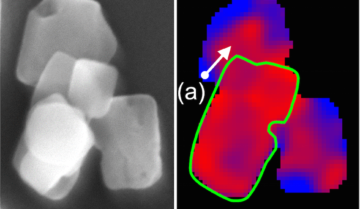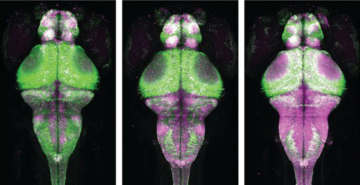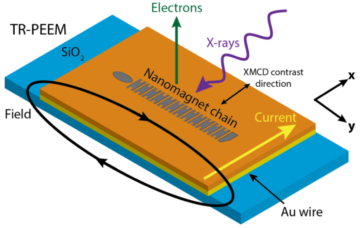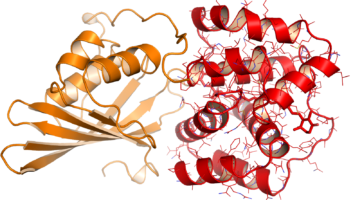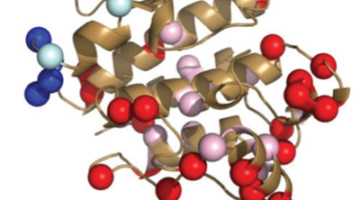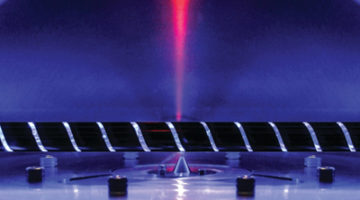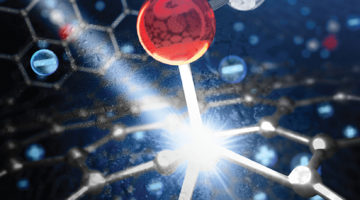For the first time, researchers have directly measured the helical pitch of twisted liquid crystals composed of achiral bent-core molecules. The work opens the door to understanding the interplay between structure and property in important organic materials, including liquid crystals, lipid tubules, and peptoids. Read more »![]()
![]()
Science Highlights
Weyl Fermions Discovered After 85 Years
Weyl fermions, elusive massless particles first theorized 85 years ago, have now been detected as emergent quasiparticles in synthetic crystals of the semimetal TaAs. The discovery could allow for the nearly free and efficient flow of electricity, as well as the realization of many fascinating topological quantum phenomena.
X-Ray Microscopy Reveals How Crystal Mechanics Drive Battery Performance
Recent findings at the ALS show that small crystal size is key to maintaining a battery’s performance and establish soft x-ray ptychography as an essential tool for studying chemical states in nanoparticles.
Read more »![]()
![]()
A Designed Protein Maps Brain Activity
A team of scientists designed and validated via x-ray crystallographic studies a fluorescent protein (CaMPARI) that allows the permanent marking of active brain cells. The protein was then used to study live changes via fluorescence in the active nerve cells in brains of fruit flies, zebrafish, and mice. Read more »![]()
![]()
Signal Speed in Nanomagnetic Logic Chains
A time-resolved x-ray imaging technique directly observes signal propagation dynamics in nanomagnetic logic (NML) chains. The technique can assess NML reliability on fast time scales and help optimize chain engineering for this promising ultralow-power computing architecture. Read more »![]()
![]()
Carotenoid Pigment Is the Key to Photoprotection
A technique newly available at the ALS has enabled the discovery of a surprising key event in photosynthetic systems. A protein shifting from an “orange” light-absorbing state to a “red” photoprotective state turns out to be an unanticipated molecular priming event in photoprotection. Read more »![]()
Ancient Proteins Help Unravel a Modern Cancer Drug’s Mechanism
The cancer drug Gleevec is extremely specific, binding and inhibiting only the cancer-causing tyrosine protein kinase Blc-Abl, while not targeting homologous protein kinases found in normal, healthy cells. Researchers at the ALS have uncovered exactly why that is the case, pointing to novel methods of drug discovery. Read more »![]()
![]()
Tracking the Elusive QOOH Radical
For the first time, researchers directly observed QOOH molecules, a class of highly reactive molecules at the center of the web of ignition chemistry reactions. The data generated will improve the fidelity of combustion models used to create cleaner and more efficient cars and trucks. Read more »![]()
![]()
Spectroscopy of Supercapacitor Electrodes In Operando
X-ray spectroscopy of graphene supercapacitor electrodes under operating conditions reveals changes in electronic structure and bonding. The research could lead to an improvement in the capacity and efficiency of electrical energy storage systems needed to meet the burgeoning demands of consumer, industrial, and green technologies. Read more »![]()
![]()
ALS X-Rays Shine a New Light on Catalysis
Recently a team of Stanford and Berkeley Lab researchers used x-rays at the ALS in a novel way to observe the behavior of electrons during technologically important chemical reactions in metal oxide electrocatalysts. What they learned has upended long-held scientific understanding of how these catalysts work. Read more »![]()
![]()
- « Previous Page
- 1
- …
- 20
- 21
- 22
- 23
- 24
- …
- 27
- Next Page »
